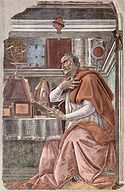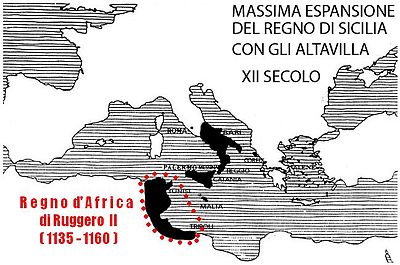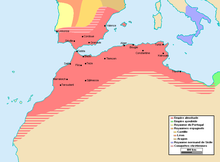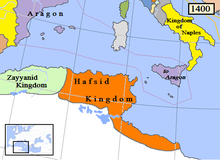History of Tunisia
Throughout its recorded history, the physical features and environment of the land of Tunisia have remained fairly constant, although during ancient times more abundant forests grew in the north,[2] and earlier in prehistory the Sahara to the south was not an arid desert.
Among the animals depicted, alone or in staged scenes, are large-horned buffalo (the extinct bubalus antiquus), elephants, donkeys, colts, rams, herds of cattle, a lion and lioness with three cubs, leopards or cheetahs, hogs, jackals, rhinoceroses, giraffes, hippopotamus, a hunting dog, and various antelope.
[14] By five thousand years ago, a Neolithic culture was evolving among the sedentary proto-Berbers of the Maghrib in northwest Africa, characterized by the practice of agriculture and animal domestication, as well as the making of pottery and finely chipped stone arrowheads.
[27] Tombs of the 13th century BC show paintings of Libu leaders wearing fine robes, with ostrich feathers in their "dreadlocks", short pointed beards, and tattoos on their shoulders and arms.
The Neolithic Revolution brought technological innovations and economic development in the eastern Mediterranean, Mesopotamia, and along the Nile, increased the demand for various metals not found locally in sufficient quantity.
[60] The Roman historian Pompeius Trogus, a near contemporary of Virgil, describes a sinister web of court intrigue which caused Queen Elissa (Dido) to flee the city of Tyre westward with a fleet of ships.
[61] The Roman poet Virgil (70–19 BC) portrays Dido as the tragic, admirable heroine of his epic the Aeneid, which contains many inventions loosely based on legendary history, and includes the story about how the Phoenician queen acquired the Byrsa.
In 480 BC (concurrent with Persia's invasion of Greece), Mago's grandson Hamilcar landed a large army in Sicily in order to confront Syracuse (a colony of Corinth) on the island's eastern coast, but the Greeks prevailed at the Battle of Himera.
Later, near Syracuse Punic armies defeated the Greek leader Agathocles (r.317–289) in battle, who then attempted a bold strategic departure by leaving Sicily and landing his forces at Cape Bon near Carthage, frightening the city.
Later, as other Phoenician ship companies entered the trading region, and so associated with the city-state, the MLK of Carthage had to keep order among a rich variety of powerful merchants in their negotiations over risky commerce across the seas.
This turnabout led to confusion in the Church, which in Northwest Africa accentuated the divide between wealthy urban members aligned with the Empire, and the local rural poor whose beliefs included social and political dissidence.
As a result of these dramatic and tumultuous events, Sassanid Persia was in disarray and confusion, and Byzantines soon retook their provinces of Egypt and Syria, but the religious discord between the local Monophysite and Eastern Orthodox Christians returned.
Some commentators speculate as to Damiya the Arabs appeared interested in booty primarily, because she then commenced to ravage and disrupt the region, making it unattractive to raiders looking for spoils of war; of course, it also made her unpopular to the residents.
Additionally, many of the Arabs who came to settle in al-Maghrib were religious and political dissidents, often Kharijites who opposed the Umayyad rulers in Damascus and embraced egalitarian doctrines, both popular positions among the Berbers of Northwest Africa.
[186] Thereafter, the 'Abbasids received an annual tribute and their suzerainty was named in the khutba at Friday prayers,[187] but their control was largely symbolic, e.g., in 864 the Caliph al-Mu'tasim "required" at a new wing be added to the Zaytuna Mosque in Tunis.
The Islamic doctrine of equality regardless of race was a cornerstone of the Sunni movement in the Maghrib, and also of the Maliki school of law as developed in Kairouan; these principles formed the core of the hostility of Ifriqiya toward rule from the east by the Caliph.
In its final decline, however, the dynasty self-destructed, when its eleventh and last amir, Ziyadat Allah III (r. 902–909) (d. 916), due to insecurity stemming from his father's assassination, ordered his rival brothers and uncles executed.
The Islamic state in Ifriqiya paralleled in many respects the government structure formed in Abbasid Baghdad,[197] There was the vizier [prime minister], the hajib [chamberlain], the sahib al-barid [master of posts and intelligence], and numerous kuttab [secretaries] (e.g., of taxation, of the mint, of the army, of correspondence).
However, both founders of the movement were recent immigrants from the Islamic east, religious dissidents: Abu 'Abdulla ash-Shi'i, originally from San'a in al-Yemen; and, coming from Salamiyah in Syria, 'Ubaidalla Sa'id (who claimed descent from Fatima the daughter of the prophet Muhammad, and who was to proclaim himself the Fatimid Mahdi).
[217] From the start the Mahdi was focused on expansion eastward, and he soon attacked Egypt with a Fatimid army of Kotama Berbers led by his son, once in 914, and again in 919, both times quickly taking Alexandria but then losing to the Abbasids.
[231] As the Banu Halali tribes took control of the plains, the local sedentary people were forced to take refuge in the mountains; in prosperous central and northern Ifriqiya farming gave way to pastoralism.
After of century of oscillation, the caliph Abu al-'Ala Idris al-Ma'mun broke with the narrow ideology of prior Almohad regimes (first articulated by the mahdi Ibn Tumart) at had continued to function on and off, and for the most part, at the end, poorly; circa 1230, he affirmed the reinstitution of the then-reviving Malikite rite, perennially popular in al-Maghrib.
At its head was often a member of the ruling nobility or musharif, called al-Caid, who not only managed the staff collecting duties but also might negotiate commercial agreements, conclude treaties, and would act as judge in legal disputes involving foreigners.
{IN PROGRESS} As a result of the initial prosperity, al-Mustansir transformed his capital Tunis, constructing a palace and the Abu Fihr park; he also created an estate near Bizerte (said by Ibn Khaldun to be without equal in the world).
[337][338] The Ottoman Empire accepted many corsairs as their agents, who made Algiers their base, including Khair al-Din [Arabic name] and his brother Aruj (both known for red beards and called Barbarossa),[339] and Uluj Ali.
Early Husaynid policy required a careful balance among several divergent parties: the Ottomans, the Turkish speaking elite in Tunisia, and local Tunisians, both urban and rural, notables and clerics, landowners and the more remote tribes.
Then Bourguiba commenced to dominate the country for the next 31 years, governing with thoughtful programs yielding stability and economic progress, repressing Islamic fundamentalism, and establishing rights for women unmatched by any other Arab nation.
The protests were sparked by the self-immolation of Mohamed Bouazizi on 17 December 2010[385][386][387] and led to the ousting of President Zine El Abidine Ben Ali 28 days later on 14 January 2011, when he officially resigned after fleeing to Saudi Arabia, ending 23 years in power.
Following the overthrow of Ben Ali, Tunisians elected a Constituent Assembly to draft a new constitution, and an interim government known as the Troika because it was a coalition of three parties; the Islamist Ennahda Movement in the lead, with the centre-left Congress for the Republic and the left-leaning Ettakatol as minority partners.
[403] In September 2021, President Kaïs Saïed announced an upcoming reform of the 2014 Constitution and the formation of a new government led by Najla Bouden Romdhane, first woman prime minister of Tunisia and the Arab world.


































